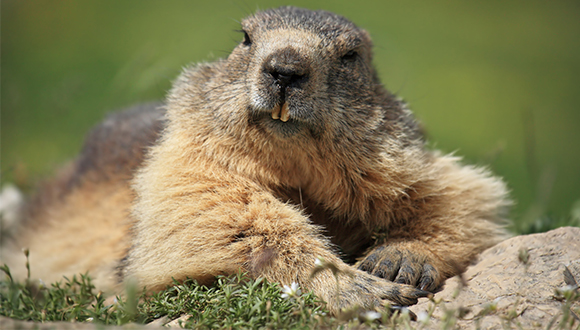Female marmots “cheat on” their male partners

For marmots, infidelity is a way for dominant females to promote genetic diversity and increase the chances of survival of their young. When the dominant partner is genetically very similar, the female opts to reproduce with other males. This behavior could help create a more diverse genetic line and genetics that are better able to respond to parasites.

A study led by CREAF and UAB researcher Mariona Ferrandiz Rovira, and published in the journal Ecology and Evolution, has revealed that while the dominant female of a group of marmots does choose the dominant male, she may also choose to engage in "adulterous" behavior depending on the same dominant male’s genetics. Data for the study were obtained from a population of marmots (Marmota marmota) in the French Alps from 1990 to 2010. The greatest number of illegitimate offspring are produced when the two members of the dominant couple are genetically either very similar or very different. "About 10% of the litters have at least one illegitimate offspring produced by copulation with a non-dominant male. It is believed that the females engage in this behavior because it can improve the genetics of the bloodline by making it more varied," explains Mariona Ferrandiz. The dominant male is chosen based on some minimum requirements Marmots are mammals which live in small groups of up to 20 individuals, and theoretically within this group only the dominant couple reproduces. Both males and females of the group have a very strong urgency to become dominant, since if they don't they have to leave the group, and chances of surviving alone in the alpine winter are very slim. The female's choice of a male depends on a group of genes related with immunological responses (major histocompatibility complex, or MHC), which should be very different to and compatible with her own. This results in a varied bloodline with a greater chance of resisting parasites. Such compatibility is the dominant male's best chance to avoid that the female copulates with other individuals. "However, this first selection of a male doesn't take into account a second genetic aspect, which is consanguinity (something like 'relatedness')," says Ferrandiz.

The role of infidelity in increased genetic variation When the dominant couple has a high degree of consanguinity or the individuals have a very similar MHC, the female corrects this by "cheating on" her mate and reproducing with other males that probably are more compatible with her genetically. It is expected that these other males' genomes will be neither very different nor very similar, and that they will have a MHC which is very different to that of the female. If this did not occur, the offspring produced by a couple with a high consanguinity and similar MHC would tend to have reduced genetic variability, which will probably result in a reduced fitness for survival and a worse immunological response.

MHC is often related to body odor Is it still unknown how females are able to detect such genetic differences. For other vertebrates such as humans and other primates, it has been observed that MHC plays a role in certain body odors and mating choices. If this is also the case for marmots then body odors may be a signal to females when searching for a mate. "This is the line of research that we want to follow now, to see if there is a relationship between odors of individuals and their genetics, specifically of the major histocompatibility complex," says the CREAF researcher. She adds, "MHC is the current hot topic of research on the immunological response of vertebrates. This complex influences natural selection because it is directly involved in bodily defenses when dealing with parasites." Although the dominant male reproduces the most, the litters of the females can include pups from different fathers, and no differences in upbringings have been observed. In fact, Mariona Ferrandiz explains, "in a previous study it was seen that the illegitimate offspring survived more than the legitimate ones, probably due to the fact that they have a greater genetic diversity." ARTICLE Ferrandiz-Rovira, M., Allainé, D., Callait-Cardinal, M.P., Cohas, A. Mate choice for neutral MHC genètic characteristics in Alpine marmots: diferent targets in different contexts? (2016). Ecology and Evolution. DOI: 10.1002/ece3.2189
Noticias relacionadas

El IPBES publica dos informes para transformar la forma en que nos relacionamos con la naturaleza, conservarla y sobrevivir

El impacto social de la investigación se consolida en la cultura científica del CREAF


